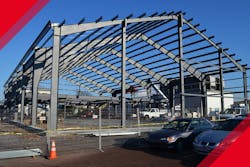Ready for earthquakes?
Earthquakes are becoming increasingly common in some parts of the U.S. where they previously were a rarity. Consequently, people who have never been exposed to them or ever had to think about earthquake safety are now facing a new reality.
There is a mistaken belief among some people that steel buildings do not do well in earthquakes. The truth is quite the opposite. In fact, steel buildings have a distinct edge over concrete in earthquakes. The reason, however, is counter-intuitive, and worth understanding.
We tend to think that the heavier and more rigid an object is, the stronger it is. This assumption is especially common regarding buildings, because our day-to-day experience validates it. If you've ever been in a wooden house during high wind, and heard the timbers creaking and groaning ominously, you might have wished the structure was concrete. We assume that the weight of concrete would help hold the house down, and the unbending nature of concrete would resist the swaying under the wind impact. That makes sense if the impacts are on the scale of a truck hitting a wall, or even a hurricane.
However, an earthquake is different than other loads. It isn't a surface force threatening to sweep the house off its foundation. The earth itself moves, moving the foundation of the building. It's more like a strong bucking bronco, trying to shake the house off its back.
The forces involved are so great that the weight of the building has nothing to do with "keeping it down." It's basic physics: Force = Mass x Acceleration. The mass of earth that's moving is so big that the weight of mere buildings is no match for it. Everything, even a very heavy structure, gets tossed around.
At that level of force, weight actually starts to work against the structure. For a given acceleration – such as a seismic tremor – the greater the mass of the building being put in motion, the greater the force exerted on the structure’s elements, and on the connections between those structural elements. In other words, the heavier the building, the more force it has to rip itself apart. A lighter structure undergoes less force from the mass of the building itself.
Steel construction is lighter in weight than concrete, without compromising strength. It has less mass – and therefore less force – to damage itself under seismic shaking. It requires less earthquake resistance to be built into the superstructure and into the foundation, potentially lowering construction costs, too.
Moreover, steel makes a more resilient structure because it is a more ductile material, allowing it to bend considerably before breaking. It will respond better in an earthquake than a more brittle structure. In smaller seismic events, a steel building is more likely to snap back than it is to crack. Should the maximum seismic event for which the building is designed occur, there may be severe deformities, but it won’t undergo progressive collapse. The building may have to be demolished afterwards, but the occupants’ safety is greater.
If earthquakes are a new phenomenon in your region and you want to know more about them, visit the US Geological Survey website at http://earthquake.usgs.gov/learn.
As earthquakes become a growing concern for more and more builders across the United States, we will likely be covering the topic more frequently. For more on this article, download the whitepaper here.

